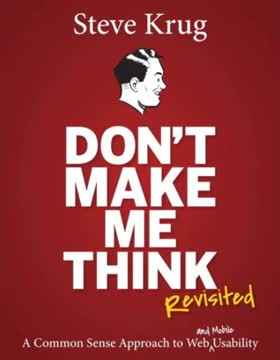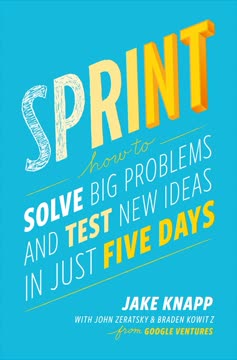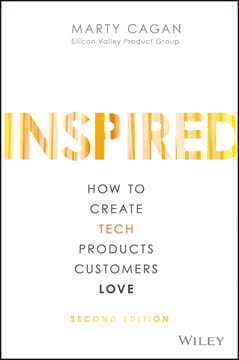Key Takeaways
1. Product-Led Growth: The Future of SaaS Success
Product-Led Growth is about helping your customers experience the ongoing value your product provides. It is a critical step in successful product design and this book shows you how it's done.
Paradigm shift. Product-Led Growth (PLG) is a go-to-market strategy that relies on the product as the primary driver of customer acquisition, activation, and retention. This approach is becoming increasingly important due to rising customer acquisition costs and decreasing willingness to pay for features. PLG aligns with modern buyers' preferences, allowing them to try products before purchasing.
Benefits of PLG:
- Wider top-of-funnel
- Lower customer acquisition costs (CAC)
- Faster sales cycles
- Higher revenue per employee
- Better user experience
Key challenges: Implementing PLG requires a shift in organizational structure and mindset. It demands a deep understanding of customer needs and continuous product improvement to deliver value quickly and consistently.
2. Choose Your Product-Led Growth Model Wisely
Freemium is like a Samurai sword: unless you're a master at using it, you can cut your arm off.
Strategic decision. Choosing between a free trial, freemium, or demo model is crucial for your PLG strategy. The decision depends on various factors, including your market strategy, ocean conditions, target audience, and time-to-value.
MOAT framework for decision-making:
- Market Strategy: Dominant, disruptive, or differentiated?
- Ocean Conditions: Red or blue ocean?
- Audience: Top-down or bottom-up selling strategy?
- Time-to-value: How quickly can users experience value?
Consider hybrid models, such as launching a new product, combining freemium with a trial, or offering a free trial followed by a freemium option. The key is to align your model with your business goals and customer needs.
3. Understand, Communicate, and Deliver Your Value
A strong brand and social proof are no longer enough to build trust with the modern buyer. You need to let people try before they buy.
UCD framework. To build a solid foundation for your product-led business, focus on three key elements: Understanding your value, Communicating your value, and Delivering on your value (UCD).
Understanding your value:
- Identify functional, emotional, and social outcomes
- Define your value metrics
Communicating your value:
- Create clear, compelling pricing pages
- Use value-based pricing strategies
Delivering on your value:
- Reduce ability debt
- Align product experience with user expectations
- Continuously improve time-to-value
By mastering these three elements, you can create a powerful PLG strategy that resonates with users and drives sustainable growth.
4. Optimize Your Pricing Strategy for Growth
If you're selling a pair of shoes, then your value metric is 'per pair of shoes' and as customers buy more pairs your business expands.
Value-based pricing. Implementing a value-based pricing strategy is crucial for PLG success. This approach aligns your revenue model with your customer acquisition model, ensuring sustainable growth.
Key elements of an effective pricing strategy:
- Use value metrics to tie pricing to customer value
- Implement tiered pricing to cater to different customer segments
- Regularly review and adjust pricing based on customer feedback and market conditions
Avoid common pitfalls, such as:
- Overcomplicating your pricing page
- Creating a free plan with no incentive to upgrade
- Making it too easy for customers to downgrade
Remember to communicate your pricing clearly and transparently, highlighting the value customers receive at each tier.
5. Master the Art of User Onboarding
People don't use software simply because they have tons of spare time and find clicking buttons enjoyable.
The Bowling Alley Framework. Create a seamless onboarding experience that guides users to experience value quickly. This framework consists of three key elements:
- Develop your straight line: Map out the shortest path to value for users
- Create product bumpers: Use in-app guidance to keep users on track
- Build conversational bumpers: Utilize external communications to guide and re-engage users
Effective product bumpers:
- Welcome messages
- Product tours
- Progress bars
- Checklists
- Onboarding tooltips
- Empty states
Focus on reducing friction and guiding users to their desired outcomes as quickly as possible. Continuously analyze and optimize your onboarding process to improve user activation and retention.
6. Create a Powerful Conversational Bumper System
The primary function of user onboarding emails is to do something your site can't: go get your users where they are and pull them back into your app.
Smart signals. Develop a conversational bumper system that adapts to user behavior and guides them through their journey. Use smart signals to trigger the right messages at the right time:
- Signup
- Quick win
- Desired outcome
- Customer
Key email types:
- Welcome emails
- Usage-tip emails
- Sales-touch emails
- Case-study emails
- Better-life emails
- Expiry-warning emails
- Post-trial survey emails
- Customer-welcome emails
Create personalized email tracks based on user behavior and engagement. Focus on delivering value and guiding users towards their desired outcomes, rather than pushing for immediate conversions.
7. Increase Average Revenue Per User (ARPU)
On average, a repeat customer will spend 67% more than a new customer.
Quality over quantity. Focusing on increasing ARPU allows for capital-efficient growth by maximizing the value of existing customers. This approach is often overlooked in favor of customer acquisition, but it can significantly impact profitability.
Strategies to optimize ARPU:
- Use value metrics in your pricing model
- Improve pricing tiers and remove unnecessary options
- Raise prices strategically
- Treat high-value users exceptionally well
- Implement effective upselling and cross-selling tactics
Remember that not all customers are created equal. Focus on attracting and retaining high-value customers who are an excellent fit for your product and have the potential for long-term growth.
8. Slay the Churn Beast for Sustainable Growth
Churn is the silent killer of your company. If you don't tackle churn early, you'll be working extremely hard just to stand still.
Holistic approach. Addressing churn is crucial for sustainable growth. Measure and tackle churn from multiple angles:
- Customer churn: Percentage of customers lost
- Revenue churn: Amount of revenue lost
- Activity churn: Users at risk of churning based on product usage
Strategies to reduce churn:
- Focus on continuous value delivery
- Implement proactive customer success initiatives
- Use activity data to identify and re-engage at-risk users
- Regularly gather and act on customer feedback
- Optimize onboarding and feature adoption
Remember that churn reduction is an ongoing process. Set incremental goals and continuously work to improve retention across all customer segments.
Last updated:
FAQ
What's "Product-Led Growth: How to Build a Product That Sells Itself" about?
- Core Concept: The book by Wes Bush introduces the Product-Led Growth (PLG) strategy, which uses the product itself as the primary means to acquire, activate, and retain customers.
- Methodology: It challenges traditional sales-led approaches by focusing on delivering value through the product, allowing users to experience its benefits firsthand.
- Target Audience: Primarily aimed at SaaS businesses, the book provides a framework for transitioning to a product-led model to drive growth.
- Outcome: By adopting PLG, companies can reduce customer acquisition costs, shorten sales cycles, and increase customer satisfaction and retention.
Why should I read "Product-Led Growth"?
- Industry Relevance: As the SaaS industry evolves, understanding PLG is crucial for staying competitive and meeting modern consumer expectations.
- Practical Frameworks: The book offers actionable strategies and frameworks, such as the MOAT and UCD frameworks, to implement PLG effectively.
- Case Studies: It includes real-world examples and case studies from successful companies like Slack and Dropbox, illustrating the benefits of PLG.
- Future-Proofing: Adopting PLG can help businesses future-proof their growth strategies against rising customer acquisition costs and changing buyer behaviors.
What are the key takeaways of "Product-Led Growth"?
- Product as a Growth Engine: The product should be the main driver of customer acquisition, activation, and retention.
- Customer Experience Focus: Prioritizing user experience in all aspects, from product design to marketing, is essential for PLG success.
- Value Delivery: Companies must understand, communicate, and deliver the value their product provides to users effectively.
- Strategic Alignment: Aligning all teams around the product and its value proposition is crucial for creating a cohesive PLG strategy.
What is the MOAT framework in "Product-Led Growth"?
- Market Strategy: Determine if your growth strategy is dominant, disruptive, or differentiated to guide your PLG approach.
- Ocean Conditions: Assess whether you are in a red or blue ocean market to tailor your strategy accordingly.
- Audience: Decide if a top-down or bottom-up marketing strategy suits your business model and target audience.
- Time-to-Value: Evaluate how quickly your product can showcase its value to users, which is critical for PLG success.
How does the UCD framework work in "Product-Led Growth"?
- Understand Your Value: Identify the functional, emotional, and social outcomes that motivate customers to buy your product.
- Communicate Your Value: Clearly convey the value proposition through pricing, marketing, and customer interactions.
- Deliver on Your Value: Ensure the product experience aligns with customer expectations to minimize the value gap.
- Iterative Process: Continuously refine your understanding, communication, and delivery of value to enhance the product-led experience.
What are the benefits of adopting a Product-Led Growth strategy?
- Lower CAC: PLG can significantly reduce customer acquisition costs by leveraging the product as the primary sales tool.
- Faster Growth: Companies can achieve faster growth by allowing users to experience the product's value firsthand.
- Higher Retention: A focus on delivering exceptional user experiences leads to higher customer satisfaction and retention rates.
- Scalability: PLG enables businesses to scale globally without the need for extensive sales teams, relying instead on the product's inherent value.
What are the best quotes from "Product-Led Growth" and what do they mean?
- "The future of growth belongs to product-led companies." This quote emphasizes the shift in business models towards PLG as a sustainable growth strategy.
- "Trying a product is and always will be an essential part of the buying process." It highlights the importance of allowing users to experience a product before purchasing.
- "Product-Led Growth isn’t just about disrupting 'how' SaaS companies sell, it’s how you survive." This underscores the necessity of PLG in adapting to changing market dynamics and consumer expectations.
- "A strong brand and social proof are no longer enough to build trust with the modern buyer." It points out the need for tangible product experiences to build trust and drive conversions.
How does "Product-Led Growth" suggest handling customer churn?
- Measure Churn: Track customer, revenue, and activity churn to get a comprehensive view of retention challenges.
- Onboarding Experience: Provide a robust onboarding process to ensure customers start on the right foot and experience value quickly.
- Usage Reviews: Send regular usage-review emails to remind customers of the value they receive from the product.
- Churn Prevention: Implement campaigns and strategies to proactively address potential churn and retain customers.
What is the Bowling Alley Framework in "Product-Led Growth"?
- Straight Line: Develop a clear path for users to achieve their desired outcomes with minimal friction.
- Product Bumpers: Use in-app guidance tools like product tours and checklists to keep users on track.
- Conversational Bumpers: Employ emails and notifications to re-engage users and guide them back to the product.
- Outcome Focus: Ensure that all efforts are directed towards helping users experience the product's core value.
How does "Product-Led Growth" address pricing strategies?
- Value-Based Pricing: Set prices based on the value provided to customers, rather than cost or competitor benchmarks.
- Pricing Tiers: Simplify pricing options to reduce decision fatigue and increase conversion rates.
- Value Metrics: Use metrics that align with customer value to determine pricing and drive revenue growth.
- Continuous Evaluation: Regularly assess and adjust pricing strategies to reflect changes in market conditions and customer needs.
What are the challenges of implementing Product-Led Growth according to Wes Bush?
- Cultural Shift: Transitioning to PLG requires a cultural shift within the organization, aligning all teams around the product.
- Complex Implementation: Successfully implementing PLG involves complex changes to product design, marketing, and sales processes.
- Risk of Cannibalization: Introducing free trials or freemium models can risk cannibalizing existing revenue streams if not managed carefully.
- Need for Expertise: Companies may need to invest in training or hiring experts to effectively execute a PLG strategy.
How does "Product-Led Growth" suggest increasing Average Revenue Per User (ARPU)?
- Value Metrics: Align pricing with value metrics that reflect the product's impact on the customer.
- Upselling and Cross-Selling: Offer additional features or products to existing customers to increase their spend.
- Pricing Adjustments: Regularly review and adjust pricing tiers to optimize revenue without alienating customers.
- Customer Segmentation: Focus on acquiring and retaining high-value customers who contribute more to ARPU.
Review Summary
Product-Led Growth receives mostly positive reviews, with readers praising its practical insights for SaaS companies. Many find it a valuable resource for understanding product-led strategies, onboarding techniques, and pricing models. The book is lauded for its concise, easy-to-read format and actionable advice. Some reviewers note that experienced professionals may find the content familiar, while others appreciate its comprehensive overview. A few criticize it for lack of depth or originality. Overall, it's recommended for those in SaaS, product management, and growth roles.
Similar Books










Download PDF
Download EPUB
.epub digital book format is ideal for reading ebooks on phones, tablets, and e-readers.




